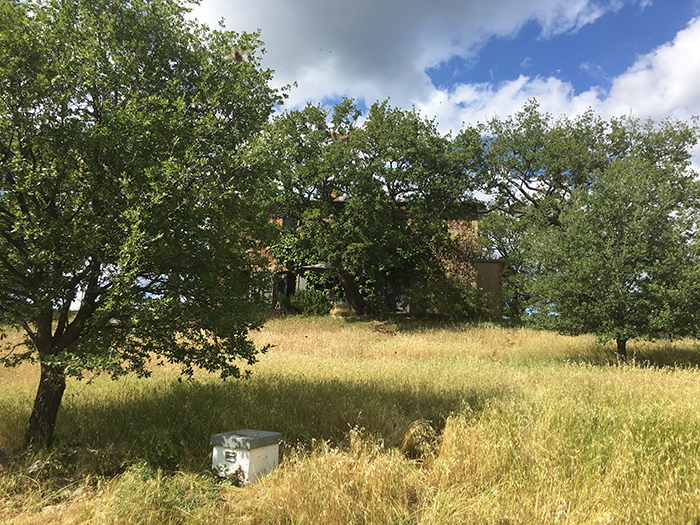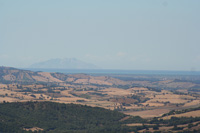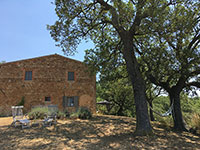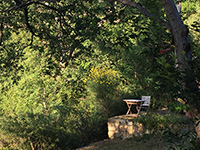A swarm of bees at Casa Vacanze Podere Santa Pia | A swarm attached to a branch |
It is generally accepted that a colony of bees does not swarm until they have completed all of their brood combs, i.e., filled all available space with eggs, larvae, and brood. This generally occurs in late spring at a time when the other areas of the hive are rapidly filling with honey stores. One key trigger of the swarming instinct is when the queen has no more room to lay eggs and the hive population is becoming very congested. Under these conditions, a prime swarm may issue with the queen, resulting in a halving of the population within the hive, leaving the old colony with a large number of hatching bees. The queen who leaves finds herself in a new hive with no eggs and no larvae but lots of energetic young bees who create a new set of brood combs from scratch in a very short time. Another important factor in swarming is the age of the queen. Those under a year in age are unlikely to swarm unless they are extremely crowded, while older queens have swarming predisposition. Beekeepers monitor their colonies carefully in spring and watch for the appearance of queen cells, which are a dramatic signal that the colony is determined to swarm. When a colony has decided to swarm, queen cells are produced in numbers varying to a dozen or more. When the first of these queen cells is sealed after eight days of larval feeding, a virgin queen pupates and is due to emerge seven days later. Before leaving, the worker bees fill their stomachs with honey in preparation for the creation of new honeycombs in a new home. This cargo of honey also makes swarming bees less inclined to sting. A newly issued swarm is noticeably gentle for up to 24 hours and is often capable of being handled by a beekeeper without gloves or veil. This swarm looks for shelter. A beekeeper may capture it and introduce it into a new hive, helping meet this need. Otherwise, it returns to a feral state, in which case it finds shelter in a hollow tree, excavation, abandoned chimney, or even behind shutters. Back at the original hive, the first virgin queen to emerge from her cell immediately seeks to kill all her rival queens still waiting to emerge. Usually, however, the bees deliberately prevent her from doing this, in which case, she too leads a second swarm from the hive. Successive swarms are called "after-swarms" or "casts" and can be very small, often with just a thousand or so bees—as opposed to a prime swarm, which may contain as many as ten to twenty-thousand bees. A small after-swarm has less chance of survival and may threaten the original hive's survival if the number of individuals left is unsustainable. When a hive swarms despite the beekeeper's preventative efforts, a good management practice is to give the reduced hive a couple frames of open brood with eggs. This helps replenish the hive more quickly and gives a second opportunity to raise a queen if there is a mating failure. Each race or sub-species of honey bee has its own swarming characteristics. Italian bees are very prolific and inclined to swarm; Northern European black bees have a strong tendency to supersede their old queen without swarming. These differences are the result of differing evolutionary pressures in the regions where each sub-species evolved.
|
 |
 |
|||
| A swarm about to land | Bee collecting pollen
|
How to capture a swarm | ||
 |
||||
The first hive at Podere Santa Pia
|
||||
 |
 |
 |
||
Queen bee (center)
|
Worker bee | Larger drones compared to smaller workers
|
||
|
||||
Podere Santa Pia |
Colline sotto Podere Santa Pia |
|||
 |
 |
 |
||
|
||||
Mappa Podere Santa Pia | Ingrandire mappa
|
||||
|
||||
| Questo articolo è basato sull' articolo Beekeeping dell' enciclopedia Wikipedia ed è rilasciato sotto i termini della GNU Free Documentation License. | ||||


